Before his death in March 2024 at the age of 78, Paul Alexander earned a law degree, wrote a memoir, and rose to fame on social media — all while using an iron lung to breathe.
The life of Paul Alexander could easily be viewed as one of tragedy: A man who could not breathe on his own, paralyzed from the neck down for seven decades due to polio. However, Alexander never let his polio or his iron lung stand in the way of him living his life.
The iron lung is a pod-like, full-body mechanical respirator. It breathes for paralyzed patients who cannot take in oxygen normally. Many of those who contracted paralytic polio would have died without the support of the iron lung, and they spent the remainder of their lives inside the device.
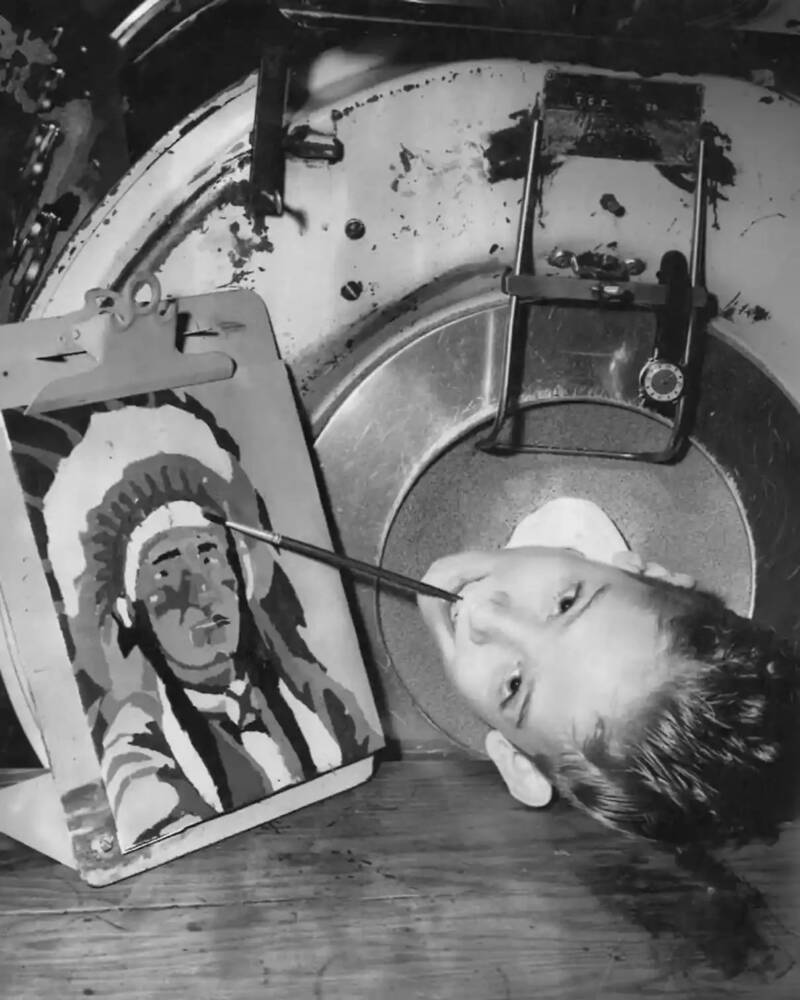
Paul AlexanderPaul Alexander relied on an iron lung to survive after he was stricken with polio at six years old.
In fact, all the doctors believed Paul Alexander would die back in 1952 when he contracted polio at age six.
He has vivid memories of being in the hospital’s polio ward and hearing the doctors talk about him. “He’s going to die today,” they said. “He shouldn’t be alive.”
But that only made him want to live all the more. So, from the confines of his iron lung, Paul Alexander did what very few people were able to do. He taught himself to breathe a different way. Then, he not only survived but thrived inside his steel ventilator until his death at the age of 78 in 2024.
Paul Alexander Contracts Polio And Starts His New Life In An Iron Lung
Young Paul Alexander’s life changed on a sweltering July day in Texas in 1952. Pools were closed, as were movie theaters and almost all other public gathering spots. The polio epidemic raged as people sheltered in place, terrified of the new sickness with no cure.
Alexander was playing outside with his brother when he suddenly felt ill and went into his house. His mother knew; he already looked like death. She called the hospital, but the staff told her there was no room for the boy. It was best to just try to recover at home.
However, after five days, Alexander lost all motor function. He could no longer hold a crayon, speak, swallow, or cough. With no other choice, his mother rushed him to the emergency room.
There, busy with other polio patients, doctors said nothing could be done. They put him on a gurney and left him in a hallway, where Alexander could hardly catch his breath. But one doctor rushing by saw him and — thinking the boy may still have a chance — whisked Paul Alexander into surgery for a tracheotomy.
Alexander woke up three days later in an iron lung, unable to move or speak. He was surrounded by a sea of other children encased in the giant ventilators, and as the months went by, he tried communicating with other kids via facial expressions. But none of his new friends lasted long. “Every time I’d make a friend, they’d die,” Alexander recalled to The Guardian in 2020.
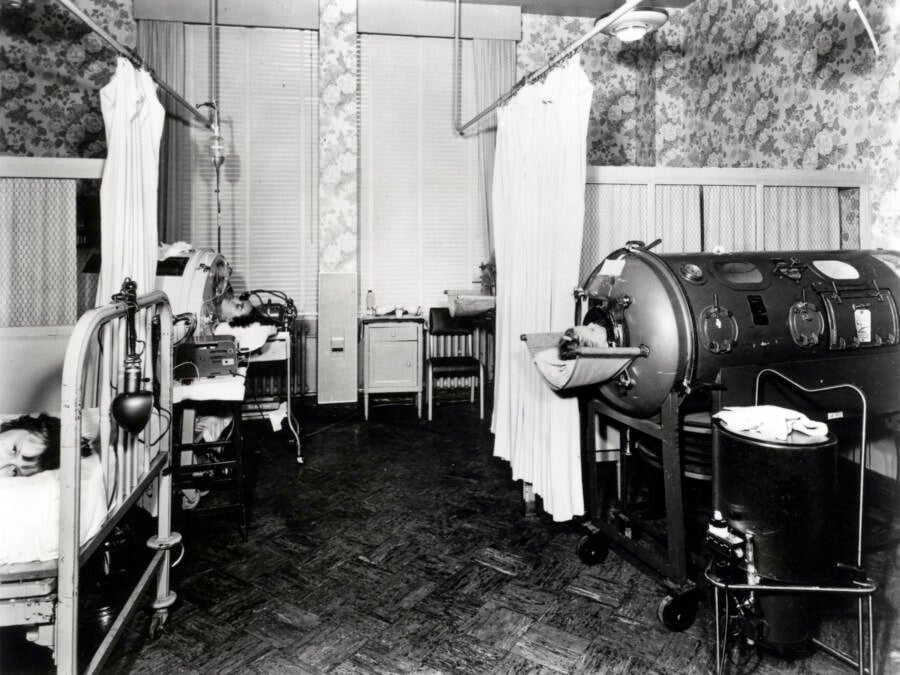
U.S. Food and Drug Administration/Wikimedia CommonsBefore the polio vaccine was invented, tens of thousands of children in the U.S. were paralyzed by polio, and some of them required iron lungs to survive.
But he didn’t die. With the help of the iron lung, Alexander kept breathing. Yet he desperately needed it. Without the device, a mechanical substitute for his diaphragm, Alexander couldn’t breathe. When he was removed by nurses for baths or to use the restroom, he had to hold his breath.
Alexander’s future didn’t look bright, but the boy — infuriated by his doctors’ lack of faith in him — was determined to defy the odds. When he got home, he started to gain weight and was slowly able to spend one hour, then two, outside of the iron lung, though he still needed to sleep inside of it.
In 1954, a physical therapist named Mrs. Sullivan got in contact with his family and offered her services. She worked with the March of Dimes, a charity dedicated to eradicating polio, and wanted to help. Before long, Sullivan started spending time with Alexander, who began to trust her despite his newfound fear of doctors and nurses.
With Sullivan’s support, Alexander practiced trapping air in his throat cavity and training his muscles to force the air down past his vocal cords and into his lungs, a technique called “frog breathing.” Sullivan told him that if he could manage to do it for three minutes, she would buy him a puppy.
It took him a year to work up to three minutes, but he didn’t stop there. Alexander wanted to play with his new puppy — who he named Ginger — outside in the sunshine.
The Man In The Iron Lung Pursues His Education
Alexander made friends once he was out of the hospital and able to leave the iron lung for longer periods, and on some afternoons, they pushed him around the neighborhood in his wheelchair. However, during the day, those friends were all busy at the one place where he desperately wanted to be: school.
His mother had already taught him the basics of reading, but the schools hadn’t let him take classes from home. Finally, they relented, and Paul caught up quickly, regaining the time he lost while in the hospital. His father engineered a pen attached to a stick that Alexander could hold in his mouth to write.
Time went by, months turned into years — and Paul Alexander graduated high school with almost straight A’s. By then, he could spend several hours in his wheelchair instead of the iron lung. The friends who once pushed him around the neighborhood took him out to restaurants, bars, and movie theaters.
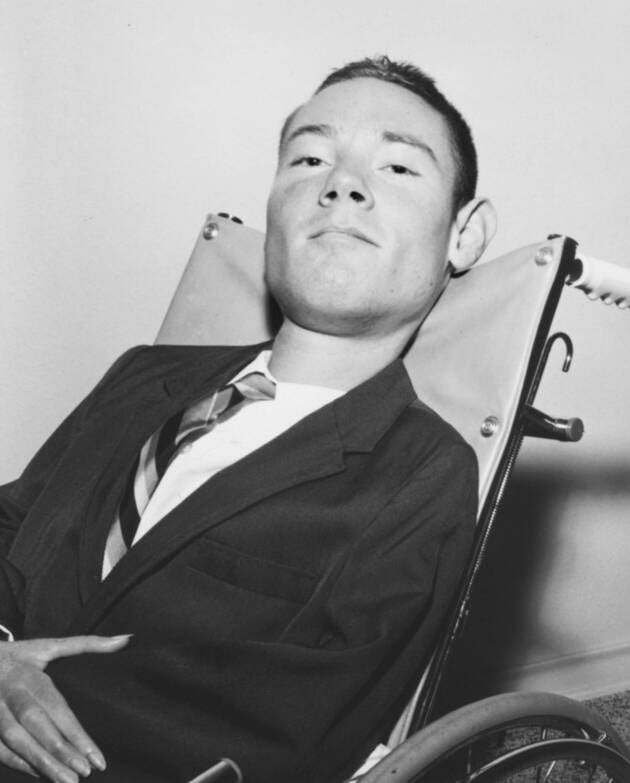
Paul AlexanderPaul Alexander in his wheelchair as a young man.
Alexander applied to Southern Methodist University, but they rejected him solely because of his disability. However, as with every task that proved difficult, Alexander did not give up. He finally convinced them to let him attend — which they did only under two conditions. Alexander would have to get the newly developed polio vaccine and find a helper to take him to class.
He even fell in love. During college, he met a girl named Claire, and they got engaged. Unfortunately, her meddling mother got in the way, refusing to let Alexander continue talking to her daughter. “Took years to heal from that,” Alexander said.
After living at home, Alexander ended up transferring to the University of Texas at Austin. He moved into a dorm and hired a caretaker to assist him with physical tasks and hygiene.
He graduated in 1978 and earned a post-graduate law degree in 1984. Not anywhere close to finished, Alexander then got a job teaching legal terminology at a trade school while he studied for the bar exam. He passed two years later.
For decades afterward, Paul Alexander worked as a lawyer around Dallas and Fort Worth. He attended court hearings in a wheelchair that propped up his paralyzed body. All the while, he continued to practice his modified form of breathing that allowed him to live outside the iron lung.

TikTok/Paul AlexanderPaul Alexander in his iron lung in January 2024.
Because a polio vaccine had been developed in the 1950s — and the disease was eradicated in the United States by the 1970s — Alexander and his iron lung increasingly became a relic of a lost age.
“You can’t believe how many people walked into my law office and saw my iron lung and said: ‘What is that?'” he recalled to The Guardian. “And I’d tell them: ‘It’s an iron lung.’ ‘What does it do?’ ‘Breathe for me.’ ‘Why?’ ‘I got polio when I was little.’ ‘What’s polio?’ Uh oh.”
He sometimes worried that polio would come back, especially since an increasing number of parents are opting out of vaccines today.
But most people have never had to experience what Paul Alexander did. He lived with his iron lung until his death in 2024 — but he never lost his optimism.
Paul Alexander’s Inspiring Life In His Final Years
By the time he reached his 70s, Paul Alexander began to rely almost exclusively on his iron lung to breathe. “It’s exhausting,” he told The Dallas Morning News of his frog breathing technique in 2018. “People think I’m chewing gum. I’ve developed it into an art.”
Still, Alexander outlived both his parents and his brother. He even outlived his original iron lung. When it began leaking air, he posted a video on YouTube asking for help. A local engineer found another one to refurbish.
Alexander relied on technology to live, but also for other things, like entertainment. An Amazon Echo sat near his iron lung. What was it mainly used for? “Rock ‘n’ roll,” he said.
Alexander also wrote a memoir titled Three Minutes for a Dog: My Life in an Iron Lung. It took him over eight years to write it, using his pen tool to type on a keyboard with his mouth or sometimes dictating passages to a friend.
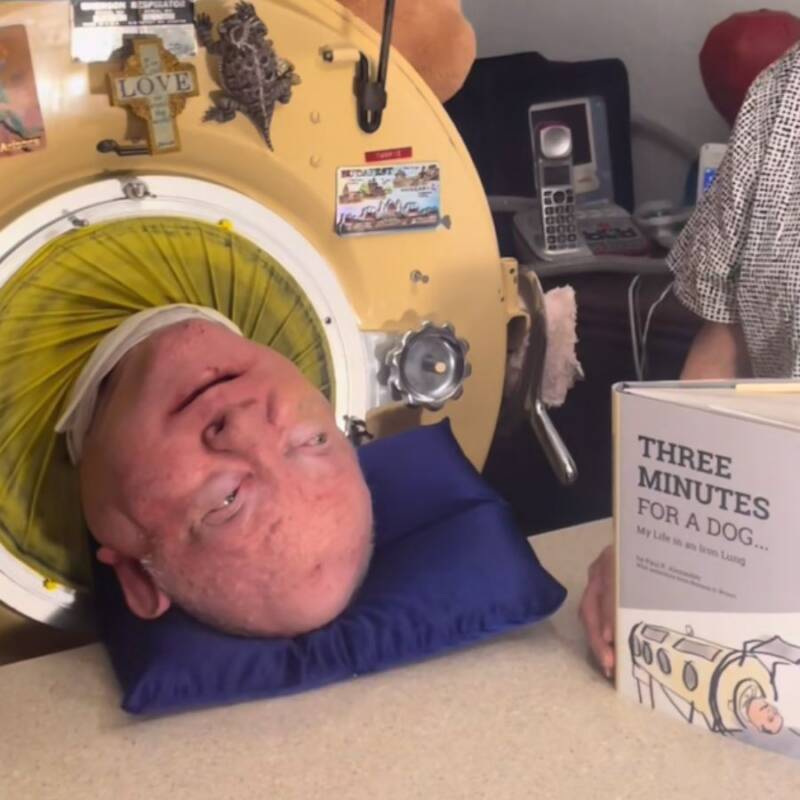
TikTok/Paul AlexanderPaul Alexander with the memoir that took him eight years to write.
Even though he needed near-constant caretaking at the end of his life, there seemed to be no slowing Paul Alexander down. He remained active in his life — and even on social media — until his death in 2024.
The Death Of Paul Alexander
Paul Alexander’s life was changed by one disease. And his death was brought about by another. In 2024, he contracted COVID-19 at the age of 78.
At the end of February 2024, Alexander tested positive for the coronavirus. In a TikTok video, his social media manager explained that he had been “rushed to the emergency” room and the disease was “really, really dangerous” for someone “in [Alexander’s] condition.”
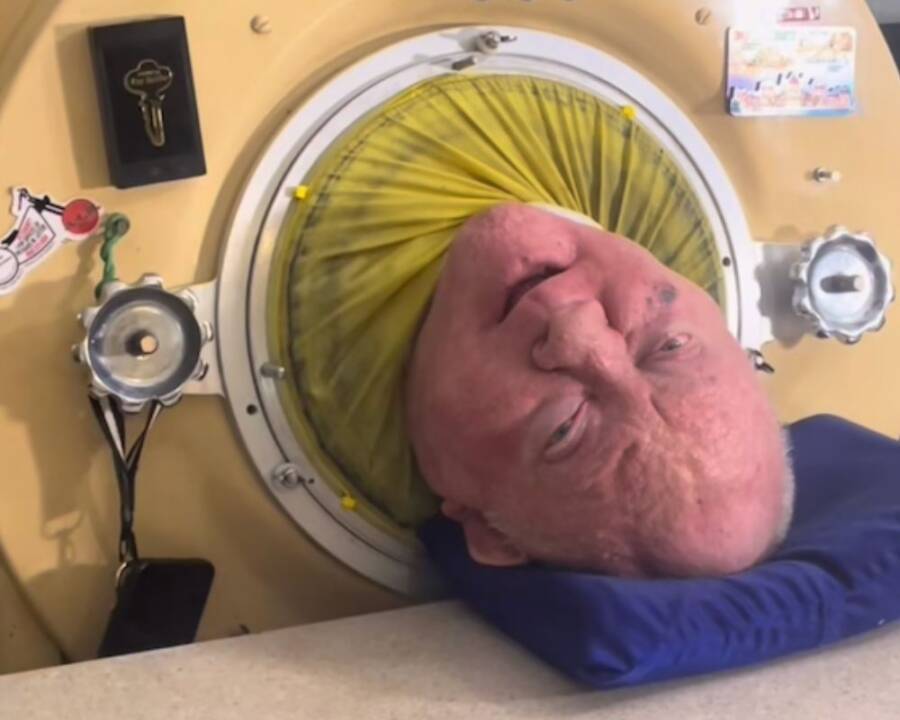
TikTok/Paul AlexanderPaul Alexander died on March 11, 2024, at the age of 78.
Though Alexander was able to return home after going to the hospital, he remained weak and showed signs of confusion. He passed away a few weeks later, on March 11, 2024.
His death marks the end of a truly inspirational life. Told by doctors that he wouldn’t live, Paul Alexander became determined not only to survive but to live well. He pursued an education, got a job, and maintained a zest for life. Alexander even kept up with new technology and had started sharing his story on TikTok in January.
“I’ve got some big dreams,” he once remarked. “I am not going to accept from anybody their limitations on my life. Not gonna do it. My life is incredible.”
After reading about the life and death of Paul Alexander, the man in the iron lung, read about how Elvis convinced America to get the polio vaccine. Then, have your faith in humanity restored by these 33 feel-good stories from history.





